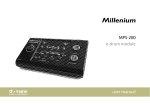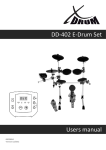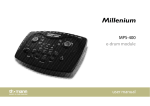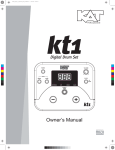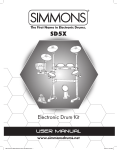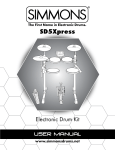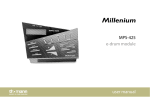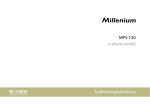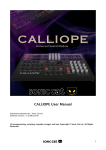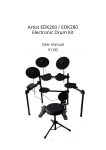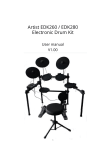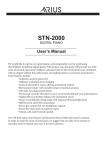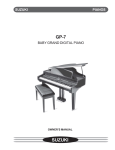Download MPS-150 e-drum module user manual
Transcript
MPS-150 e-drum module user manual Musikhaus Thomann Thomann GmbH Hans-Thomann-Straße 1 96138 Burgebrach Germany Telephone: +49 (0) 9546 9223-0 E-mail: [email protected] Internet: www.thomann.de 26.10.2015, ID: 360221 Table of contents Table of contents 1 General information................................................................................................................................. 1.1 Further information........................................................................................................................... 1.2 Notational conventions.................................................................................................................... 1.3 Symbols and signal words............................................................................................................... 5 6 7 9 2 Safety instructions.................................................................................................................................. 11 3 Features....................................................................................................................................................... 14 4 Installation.................................................................................................................................................. 15 5 Connections and operating elements........................................................................................... 18 6 Operating.................................................................................................................................................... 6.1 Functions............................................................................................................................................. 6.2 Demo song......................................................................................................................................... 6.3 Playing and adjusting patterns................................................................................................... 6.4 Selecting and adjusting drum kits............................................................................................. 6.5 Click (metronome) set up and use............................................................................................. 6.6 Menu overview................................................................................................................................. 23 23 25 25 28 33 37 MPS-150 3 Table of contents 7 Technical specifications....................................................................................................................... 38 8 Plug and connection assignment.................................................................................................... 40 9 Cleaning....................................................................................................................................................... 42 10 Protecting the environment.............................................................................................................. 43 11 Appendix..................................................................................................................................................... 11.1 Voice list............................................................................................................................................ 11.2 Kit list.................................................................................................................................................. 11.3 Pattern list........................................................................................................................................ 11.4 MIDI implementation................................................................................................................... 11.5 General MIDI Backing Instrument List.................................................................................... 11.6 General MIDI Drum Kit List......................................................................................................... e-drum module 4 44 44 48 49 51 54 62 General information 1 General information This manual contains important instructions for the safe operation of the unit. Read and follow the safety instructions and all other instructions. Keep the manual for future reference. Make sure that it is available to all those using the device. If you sell the unit please make sure that the buyer also receives this manual. Our products are subject to a process of continuous development. Thus, they are subject to change. MPS-150 5 General information 1.1 Further information On our website (www.thomann.de) you will find lots of further information and details on the following points: Download This manual is also available as PDF file for you to download. Keyword search Use the search function in the electronic version to find the topics of interest for you quickly. Online guides Our online guides provide detailed information on technical basics and terms. Personal consultation For personal consultation please contact our technical hotline. Service If you have any problems with the device the customer service will gladly assist you. e-drum module 6 General information 1.2 Notational conventions This manual uses the following notational conventions: Letterings The letterings for connectors and controls are marked by square brackets and italics. Examples: [VOLUME] control, [Mono] button. Displays Texts and values displayed on the device are marked by quotation marks and italics. Examples: ‘24ch’ , ‘OFF’ . MPS-150 7 General information Instructions The individual steps of an instruction are numbered consecutively. The result of a step is indented and highlighted by an arrow. Example: 1. Switch on the device. 2. Press [Auto]. ð Automatic operation is started. 3. Cross-references Switch off the device. References to other locations in this manual are identified by an arrow and the specified page number. In the electronic version of the manual, you can click the cross-reference to jump to the specified location. Example: See Ä ‘Cross-references’ on page 8. e-drum module 8 General information 1.3 Symbols and signal words In this section you will find an overview of the meaning of symbols and signal words that are used in this manual. Signal word Meaning DANGER! This combination of symbol and signal word indicates an immediate dangerous situation that will result in death or serious injury if it is not avoided. CAUTION! This combination of symbol and signal word indicates a pos‐ sible dangerous situation that can result in minor injury if it is not avoided. NOTICE! This combination of symbol and signal word indicates a pos‐ sible dangerous situation that can result in material and environmental damage if it is not avoided. MPS-150 9 General information Warning signs Type of danger Warning – danger zone. e-drum module 10 Safety instructions 2 Safety instructions Intended use Drum modules are intended to be used for converting digital trigger signals from drum pads to various percussion sounds. Use the unit only as described in this manual. Any other use or use under other operating conditions is considered to be improper and may result in personal injury or property damage. No liability will be assumed for damages resulting from improper use. This device may be used only by persons with sufficient physical, sensorial, and intellectual abilities and having corresponding knowledge and experience. Other persons may use this device only if they are supervised or instructed by a person who is responsible for their safety. MPS-150 11 Safety instructions Safety DANGER! Danger for children Ensure that plastic bags, packaging, etc. are disposed of properly and are not within reach of babies and young children. Choking hazard! Ensure that children do not detach any small parts (e.g. knobs or the like) from the unit. They could swallow the pieces and choke! Never let children unattended use electrical devices. CAUTION! Possible hearing damage With loudspeakers or headphones connected, the device can produce volume levels that may cause temporary or permanent hearing impairment. Do not operate the device permanently at a high volume level. Decrease the volume level immediately if you experience ringing in your ears or hearing impairment. e-drum module 12 Safety instructions NOTICE! Operating conditions This device has been designed for indoor use only. To prevent damage, never expose the device to any liquid or moisture. Avoid direct sunlight, heavy dirt, and strong vibrations. NOTICE! External power supply The device is powered by an external power supply. Before connecting the external power supply, ensure that the input voltage (AC outlet) matches the voltage rating of the device and that the AC outlet is protected by a residual cur‐ rent circuit breaker. Failure to do so could result in damage to the device and pos‐ sibly the user. Unplug the external power supply before electrical storms occur and when the device is unused for long periods of time to reduce the risk of electric shock or fire. MPS-150 13 Features 3 Features n n n n n n n n 108 voices 10 preprogrammed drum kits 40 preprogrammed songs Metronome Flexible assignment of pad voices Reverb effect, voice tuning Individual adjustment of accompaniment and drum track Connections for headphones, AUX, USB and MIDI e-drum module 14 Installation 4 Installation Setup, connecting pads and pedals Setup and assembly of the pads and pedals are described in detail in the enclosed assembly guide. Finally, check that all connecting cables are correctly connected between the pads and the drum module. Connecting the power adapter Connect the included power adapter to the 9V connector of the unit and then plug the power adapter into a wall outlet. MPS-150 15 Installation Connecting headphones Connect your stereo headphones to the PHONES output of the drum module. Connecting audio devices Connect the inputs of your amplifier or active monitors to the OUTPUT sockets of the drum module. If you use a mono amplifier, connect its input to the output L / MONO socket of the module. e-drum module 16 Installation Connecting a CD or MP3 player Connect your CD or MP3 player to the input socket AUX IN of the drum module. Connecting MIDI devices Connect external MIDI devices to the MIDI OUT socket of the drum module. Connecting USB devices Connect external MIDI devices or your computer to the USB port of the drum module. MPS-150 17 Connections and operating elements 5 Connections and operating elements Front panel e-drum module 18 Connections and operating elements 1 [START / STOP] Button to start and stop song playback. 2 [VOLUME] Volume control for audio and headphones output. 3 3-digit LED display. 4 [CLICK] | [DEMO] Button to turn the metronome on and off and to play the demo song. 5 [MODE] Button to open the selection menu. 6 [PAGE] Button to scroll through the open menu. 7 [+] / [–] Increases or decreases the currently displayed value. MPS-150 19 Connections and operating elements Rear panel e-drum module 20 Connections and operating elements 8 [9 V] Connection socket for the power adapter. 9 [ON / OFF] Main switch to turn the device on and off. 10 [USB] Connection socket for USB cable. 11 [MIDI OUT] Connection socket for an external MIDI device to send MIDI commands. 12 [OUTPUT – R / L/MONO] Output for external audio devices (mono / stereo). 13 [AUX IN] Input for external audio devices like MP3 or CD players. 14 [PHONES] Connection socket for headphones. MPS-150 21 Connections and operating elements Bottom 15 Multiple socket for connecting the pads. e-drum module 22 Operating 6 Operating 6.1 Functions Switching on Check all cable connections for correct fit before turning on. Before switching on, turn the volume control [VOLUME] to minimum. Turn the drum module on using the main switch [ON/OFF] on the rear side of the unit. MPS-150 23 Operating Automatic shutoff – When the device is not used it automatically shuts off after 30 minutes. To turn it back on set the on / off switch to ‘OFF’ and then to ‘ON’ again. Disabling automatic shutoff – Adjusting the volume To disable the automatic shut-off, press and keep the button [START / STOP] pressed while turning the device on. The message ‘PoF’ appears in the display. To adjust the volume strike a pad while turning the volume control [VOLUME] slowly clockwise. e-drum module 24 Operating 6.2 Demo song To play the preprogrammed demo piece, proceed as follows: 1. Press [CLICK] for about two seconds. ð The preprogrammed demo song sounds, ‘dE’ appears on the display. 2. Stop playback with [START / STOP]. 6.3 Playing and adjusting patterns Selecting patterns Your digital drum set features a total of 40 preprogrammed patterns. Pattern ‘001’ is displayed by default when the drum module is turned on. 1. Press [MODE] repeatedly until the LED [PATTERN] lights up. ð The display shows the pattern number. 2. Use the buttons [–] and [+] to select the desired pattern (see Ä Chapter 11.3 ‘Pattern list’ on page 49). MPS-150 25 Operating Playing patterns 1. Select the desired pattern as described above. 2. Start and stop playback with [START / STOP]. 1. Press [MODE] repeatedly until the LED [PATTERN] lights up. Adjusting pattern volume ð The display shows the pattern number. 2. Press [PAGE]. ð The pattern volume appears in ‘Axx’ format on the display. 3. Adjust the volume using the buttons [–] and [+] in a range from 00 to 32. The setting is automatically stored. Adjusting drum volume 1. Press [MODE] repeatedly until the LED [PATTERN] lights up. ð The display shows the pattern number. e-drum module 26 Operating 2. Press [PAGE]. ð The drum volume appears in ‘dxx’ format on the display. 3. Adjust the volume using the buttons [–] and [+] in a range from 00 bis 32. The setting is automatically stored. Adjusting playback speed 1. Simultaneously press [MODE] and [PAGE] ð The display shows the playback speed. 2. Adjust the playback speed using the buttons [–] and [+] (setting range: 30 to 280 beats per minute). The setting is automatically stored. MPS-150 27 Operating 6.4 Selecting and adjusting drum kits You can select one of the preprogrammed drum kits. The preprogrammed voices of the drum module can be programmed to any of the connected pads. Selecting a drum kit To select a certain drum kit, proceed as follows: 1. Press [MODE] repeatedly until the LED [KIT] lights up. ð The display shows the kit number. 2. Use the buttons [–] and [+] to select the desired kit (see Ä Chapter 11.2 ‘Kit list’ on page 48). The setting is automatically stored. Adjusting kit volume 1. Press [MODE] repeatedly until the LED [KIT] lights up. ð The display shows the kit number. e-drum module 28 Operating 2. Press [PAGE]. ð The kit volume appears in ‘Lxx’ format on the display. 3. Adjust the volume using the buttons [–] and [+] in a range from 00 bis 32. The setting is automatically stored. Turning Reverb on / off To turn the Reverb effect on or off, proceed as follows: 1. Press [MODE] repeatedly until the LED [KIT] lights up. ð The display shows the kit number. 2. Press [PAGE]. ð The current Reverb setting appears in the display ( ‘roN’ : on or ‘roF’ : off). 3. Change the setting using the buttons [–] and [+]. The setting is automatically stored. MPS-150 29 Operating Assigning a Voice To programme a certain Voice for a pad, proceed as follows: 1. Press [MODE] repeatedly until the LED [VOICE] lights up. 2. Hit the respective pad to activate it. ð The display shows the number of the currently assigned Voice. 3. Select the desired Voice using the buttons [–]/[+] (see Ä Chapter 11.1 ‘ Voice list’ on page 44). The setting is automatically stored. Only Voices from group 1 – group 4 can be assigned to a Hi-Hat. The display shows ‘H-I’ . e-drum module 30 Operating Adjusting Voice volume You have the option to adjust the volume of each voice independently. To do so proceed as follows: 1. Press [MODE] repeatedly until the LED [VOICE] lights up. 2. Hit the respective pad to activate it. ð The Voice volume appears in ‘Lxx’ format on the display. 3. Adjust the volume using the buttons [–]/[+] (setting range: 0 to 32). The setting is automatically stored. MPS-150 31 Operating Adjusting assigned MIDI note You have the option to change the MIDI note assigned to a pad. To do so proceed as follows: 1. Press [MODE] repeatedly until the LED [VOICE] lights up. 2. Hit the respective pad to activate it. ð The number assigned to the MIDI note appears in ‘Nxx’ format on the display. 3. Adjust the number using the buttons [–]/[+] (setting range: 0 to 99). The setting is automatically stored. The following table shows the MIDI mapping in default setting. No. Name Assigned MIDI note 1 Crash 1 49 2 Tom 1 48 3 Tom 2 45 4 Tom 3 43 e-drum module 32 Operating No. Name Assigned MIDI note 5 Ride 51 6 Kick 36 7 Snare 38 8 Hi-Hat close 42 9 Hi-Hat open 46 10 Hi-Hat pedal 44 6.5 Click (metronome) set up and use Using Click function 1. Press [CLICK] to turn the Click on. ð The LED [CLICK] flashes in step, the Click sounds. 2. Press again [CLICK]to turn the Click off. MPS-150 33 Operating Setting the time signature 1. Press [MODE] repeatedly until the LED [CLICK] lights up. 2. Press [PAGE]. ð The time signature appears on the display, for example ‘4-4’ . 3. Choose the time signature using the buttons [–] and [+] from a selection of 1/4 to 7/4, 3/8 and 6/8. The setting is automatically stored. Click tempo and time signature are automatically adjusted when playing patterns and can not be changed. e-drum module 34 Operating Setting Click interval 1. Press [MODE] repeatedly until the LED [CLICK] lights up. 2. Press [PAGE]. ð The Click interval appears on the display, for example ‘--4’ . 3. Select the Click interval using the buttons [–] and [+]. Possible values are: 1/4, 1/8, 1/12, 1/16, 1/24, default value: 1/4. The setting is automatically stored. Setting the Click sound 1. Press [MODE] repeatedly until the LED [CLICK] lights up. 2. Press [PAGE]. ð The set sound, the so-called ‘click instrument’ is displayed in ‘CLx’ format. 3. Use the buttons [–] and [+] to select the sound. Possible values are: CL1 – CL5, default value: CL1. The setting is automatically stored. MPS-150 35 Operating Setting the Click volume 1. Press [MODE] repeatedly until the LED [CLICK] lights up. 2. Press [PAGE]. ð The set volume appears on the display, for example ‘L24’ . 3. Adjust the volume using the buttons [–] and [+] in a range from 0 bis 32. The setting is automatically stored. e-drum module 36 Operating 6.6 Menu overview MPS-150 37 Technical specifications 7 Technical specifications Number of voices 108 Drum kits 10 preset kits Songs 40 Songs e-drum module 38 Technical specifications Connections Headphones (1/4" phone socket) AUX in (1/4" phone socket) Left mono out (1/4" phone socket) Stereo out right / left (1/4" phone socket) 1 × Kick pad 1 × Snare pad 3 × Tom pads 1 × Crash pad 1 × Ride pad 1 × Hi-Hat 1 × Hi-Hat control MIDI out USB port Operating supply voltage Power adapter (9 V ) MPS-150 39 Plug and connection assignment 8 Plug and connection assignment Introduction This chapter will help you select the right cables and plugs to connect your valuable equip‐ ment in such a way that a perfect sound experience is ensured. Please note these advices, because especially in ‘Sound & Light’ caution is indicated: Even if a plug fits into the socket, an incorrect connection may result in a destroyed power amp, a short circuit or ‘just’ in poor transmission quality! Balanced and unbalanced trans‐ mission Unbalanced transmission is mainly used in semi-professional environment and in hifi use. Instrument cables with two conductors (one core plus shielding) are typical representatives of the unbalanced transmission. One conductor is ground and shielding while the signal is trans‐ mitted through the core. Unbalanced transmission is susceptible to electromagnetic interference, especially at low levels, such as microphone signals and when using long cables. In a professional environment, therefore, the balanced transmission is preferred, because this enables an undisturbed transmission of signals over long distances. In addition to the conduc‐ tors ‘Ground’ and ‘Signal’, in a balanced transmission a second core is added. This also transfers the signal, but phase-shifted by 180°. e-drum module 40 Plug and connection assignment Since the interference affects both cores equally, by subtracting the phase-shifted signals, the interfering signal is completely neutralized. The result is a pure signal without any noise inter‐ ference. 1/4" TS phone plug (mono, unbalanced) 1 Signal 2 Ground, shielding 1 Signal (in phase, +) 2 Signal (out of phase, –) 3 Ground 1/4" TRS phone plug (mono, bal‐ anced) MPS-150 41 Cleaning 9 Cleaning Device parts Clean the accessible parts of the device regularly. The frequency of cleaning depends on the operating environment: moist, smoky or particularly dirty environments may cause a higher accumulation of dirt on the components of the device. n n n n Use a dry soft cloth for cleaning. Remove stubborn stains with a slightly damp cloth. Never use cleaners containing alcohol or thinner. Never put any vinyl items on the device, as vinyl can stick to the surface or lead to its disco‐ louration. e-drum module 42 Protecting the environment 10 Protecting the environment Disposal of the packaging mate‐ rial For the transport and protective packaging, environmentally friendly materials have been chosen that can be supplied to normal recycling. Ensure that plastic bags, packaging, etc. are properly disposed of. Do not just dispose of these materials with your normal household waste, but make sure that they are collected for recycling. Please follow the notes and markings on the packaging. Disposal of your old device This product is subject to the European Waste Electrical and Electronic Equipment Directive (WEEE). Do not dispose with your normal household waste. Dispose of this device through an approved waste disposal firm or through your local waste facility. When discarding the device, comply with the rules and regulations that apply in your country. If in doubt, consult your local waste disposal facility. MPS-150 43 Appendix 11 11.1 No. Appendix Voice list Name KICK No. Name No. Name 009 Jazz Kick 1 017 Classic Snare 2 001 Standard Kick 1 010 Jazz Kick 2 018 Classic Snare Rim 2 002 Standard Kick 2 011 Electronic Kick 019 Room Snare 1 003 Room Kick 012 808 Kick 020 Room Snare 2 004 Rock Kick 1 013 House Kick 1 021 Acoustic Snare 005 Rock Kick 2 014 House Kick 2 022 Acoustic Snare Rim 006 Acoustic Kick SNARE 023 Funk Band Snare 007 HipHop Kick 015 Classic Snare 1 024 Funk Band Rim 008 Funk Kick 016 Classic Snare Rim 1 025 Camco Snare e-drum module 44 Appendix No. Name No. Name No. Name 026 Camco Snare Rim 038 Classic Tom 5 051 808 Tom 6 027 Brush Snare 039 Classic Tom 6 052 Electronic Tom 1 028 Brush Snare Rim 040 Camco Tom 1 053 Electronic Tom 2 029 Electronic Snare 1 041 Camco Tom 2 054 Electronic Tom 3 030 Electronic Snare 2 042 Camco Tom 3 055 Electronic Tom 4 031 808 Snare 043 Camco Tom 4 056 Electronic Tom 5 032 House Snare 1 044 Camco Tom 5 057 Electronic Tom 6 033 House Snare 2 045 Camco Tom 6 RIDE 046 808 Tom 1 058 Classic Ride TOM 034 Classic Tom 1 047 808 Tom 2 059 Classic Ride Bell 035 Classic Tom 2 048 808 Tom 3 060 Rock Ride 036 Classic Tom 3 049 808 Tom 4 061 808 Ride 037 Classic Tom 4 050 808 Tom 5 MPS-150 45 Appendix No. Name CRASH No. Name No. Name 073 Standard Hi-hat Close 085 Conga Low 062 Standard Crash 1 074 Jazz Hi-hat Close 086 Timbale High 063 Standard Crash 2 075 Electronic Hi-hat Close 087 Timbale Low 064 Rock Crash 076 808 Hi-hat Close 088 Agogo High 065 Splash 1 077 Standard Hi-hat Pad 089 Agogo Low 066 Splash 2 078 Jazz Hi-hat Pad 090 Cabasa 067 Brush Crash 079 Electronic Hi-hat Pad 091 Maracas 068 808 Crash 080 808 Hi-hat Pad 092 Short Whistle PERCUSSION 093 Long Whistle HI-HAT 069 Standard Hi-hat Open 081 Bongo High 094 Short Guiro 070 Jazz Hi-hat Open 082 Bongo Low 095 Long Guiro 071 Electronic Hi-hat Open 083 Mute Conga Hi-hat 096 Claves 072 808 Hi-hat Open 084 Open Conga Hi-hat 097 Wood Block High e-drum module 46 Appendix No. Name 098 Wood Block Low 099 Mute Cuica 100 Open Cuica 101 Mute Triangle 102 Open Triangle 103 Shaker 104 Jingle Bell 105 Belltree 106 Castanets 107 Mute Surdo 108 Open Surdo MPS-150 47 Appendix 11.2 Kit list No. Name 001 Acoustic 002 Standard 1 003 Rock 004 Standard 2 005 Funk 006 Jazz 007 Brush 008 Electronic 009 808 010 House e-drum module 48 Appendix 11.3 Pattern list No. Name Tempo Kit No. Name Tempo Kit 001 Fusion 1 103 1 011 Funk 3 120 5 002 Electronic & Funk 116 9 012 Fusion 3 108 1 003 Modern Pop 136 1 013 Fusion 4 116 1 004 HipHop 110 9 014 Pop Funk 2 106 5 005 Latin Jazz 1 130 7 015 R&B 86 9 006 Funk 1 120 5 016 Drum & Bass 1 168 9 007 Big Band 1 170 6 017 Break Beat 108 5 008 Funk 2 112 1 018 Dance 130 9 009 Pop Funk 1 112 1 019 Drum & Bass 2 170 1 010 Fusion 2 112 1 020 Latin Dance 126 5 MPS-150 49 Appendix No. Name Tempo Kit No. Name Tempo Kit 021 Swing 172 6 032 Mambo 126 5 022 Latin Jazz 2 126 7 033 Latin Rock 136 1 023 Big Band 2 152 6 034 Latin Pop 126 5 024 3/4 Jazz 120 7 035 Guitar Bossa 84 5 025 Jazz 150 7 036 Country Blues 128 3 026 6/8 Ballad 96 3 037 Rock 100 1 027 Pop Ballad 80 3 038 Reggae 78 1 028 Pop Bossa 120 2 039 60’s Rock 120 2 029 16Beat Pop 120 5 040 Blues 96 2 030 Pop Shuffle 86 5 Demo Funk 100 1 031 Samba 236 1 e-drum module 50 Appendix 11.4 MIDI implementation Function Basic channel Mode Transmitted Recognized Default Ch 10 1-16 Changed No No Default No No Messages No No Altered ******** ******** 0…127 0…127 True voice ******** 0…127 Note ON Yes (99H, V=1…127) 0…127 Note OFF Yes (99H, V=0) 0…127 Keys No No Channels No No Note number Velocity Aftertouch Remarks MPS-150 51 Appendix Function Transmitted Recognized Pitch bender No Yes 0 No Yes Bank select 1 No Yes Modulation 5 No Yes Portamento time 6 No Yes Data entry 7 No Yes Volume 10 No Yes Pan 11 No Yes Expression 64 No Yes Sustain pedal 65 No Yes Portamento ON/OFF 66 No Yes Sostenuto pedal 67 No Yes Soft pedal 80 No Yes Reverb program Control change e-drum module 52 Remarks Appendix Function Transmitted Recognized Remarks 81 No Yes Chorus program 91 No Yes Reverb level 93 No Yes Chorus level 120 No Yes All Sound Off 121 No Yes Reset All Controllers 123 No Yes All Notes Off Program change Yes Yes System exclusive No Yes Song Position No No Song Select No No Tune No No Clock Yes No Command Yes No System common System real time START and STOP only MPS-150 53 Appendix Function Aux messages 11.5 No. Transmitted Recognized Local ON/OFF No No All Notes OFF No No Active Sense Yes No System reset No No General MIDI Backing Instrument List Name Piano No. Name Mallet 1 Acoustic Grand Piano 9 Celesta 2 Bright Acoustic Piano 10 Glockenspiel 3 Electric Grand Piano 11 Music Box e-drum module 54 Remarks Appendix No. Name No. Name 4 Honky-Tonk Piano 12 Vibraphone 5 Electric Piano 1 13 Marimba 6 Electric Piano 2 14 Xylophone 7 Harpsichord 15 Tubular Bells 8 Clavi 16 Dulcimer No. Name No. Name Organ Guitar 17 Drawbar Organ 25 Nylon Guitar 18 Percussive Organ 26 Steel Guitar 19 Rock Organ 27 Jazz Guitar 20 Church Organ 28 Clean Guitar MPS-150 55 Appendix No. Name No. Name 21 Reed Organ 29 Muted Guitar 22 Accordion 30 Overdriven Guitar 23 Harmonica 31 Distortion Guitar 24 Tango Accordion 32 Guitar Harmonics No. Name No. Name Bass Strings 33 Acoustic Bass 41 Violin 34 Finger Bass 42 Viola 35 Pick Bass 43 Cello 36 Fretless Bass 44 Contrabass 37 Slap Bass 1 45 Tremolo Strings e-drum module 56 Appendix No. Name No. Name 38 Slap Bass 2 46 Pizzicato Strings 39 Synth Bass 1 47 Orchestral Harp 40 Synth Bass 2 48 Timpani No. Name No. Name Strings Ensemble Brass 49 String Ensembles 1 57 Trumpet 50 String Ensembles 2 58 Trombone 51 Synth Strings 1 59 Tuba 52 Synth Strings 2 60 Muted Trumpet 53 Choir Aahs 61 French Horn 54 Voice Oohs 62 Brass Section MPS-150 57 Appendix No. Name No. Name 55 Synth Voice 63 Synth Brass 1 56 Orchestra Hit 64 Synth Brass 2 No. Name No. Name Reed Pipe 65 Soprano Sax 73 Piccolo 66 Alto Sax 74 Flute 67 Tenor Sax 75 Recorder 68 Baritone Sax 76 Pan Flute 69 Oboe 77 Blown Bottle 70 English Horn 78 Shakuhachi e-drum module 58 Appendix No. Name No. Name 71 Bassoon 79 Whistle 72 Clarinet 80 Ocarina No. Name No. Name Synth Lead Pad 81 Lead 1 (square) 89 Pad 1 (new age) 82 Lead 2 (sawtooth) 90 Pad 2 (warm) 83 Lead 3 (calliope) 91 Pad 3 (polysynth) 84 Lead 4 (chiff) 92 Pad 4 (choir) 85 Lead 5 (charang) 93 Pad 5 (bowed) 86 Lead 6 (voice) 94 Pad 6 (metallic) MPS-150 59 Appendix No. Name No. Name 87 Lead 7 (fifths) 95 Pad 7 (halo) 88 Lead 8 (bass + lead) 96 Pad 8 (sweep No. Name No. Name Effects Ethnic 97 FX 1 (rain) 105 Sitar 98 FX 2 (soundtrack) 106 Banjo 99 FX 3 (crystal) 107 Shamisen 100 FX 4 (atmosphere) 108 Koto 101 FX 5 (brightness) 109 Kalimba 102 FX 6 (goblins) 110 Bagpipe e-drum module 60 Appendix No. Name No. Name 103 FX 7 (echoes) 111 Fiddle 104 FX 8 (sci-fi) 112 Shanai No. Name No. Name Percussive Sound Effects 113 Tinkle Bell 121 Guitar Fret Noise 114 Agogo 122 Breath Noise 115 Steel Drums 123 Seashore 116 Wood Block 124 Bird Tweet 117 Taiko Drum 125 Telephone Ring 118 Melodic Tom 126 Helicopter MPS-150 61 Appendix No. Name No. Name 119 Synth Drum 127 Applause 120 Reverse Cymbal 128 Gunshot 11.6 General MIDI Drum Kit List Note Standard 1 (bank 0) Standard 2 (bank 4) Room (bank 8 ) Rock (bank 16 ) Funk (bank 17 ) 27 – D#1 High Q <- <- <- <- 28 – E1 Slap <- <- <- <- 29 – F1 Scratch Push <- <- <- <- 30 – F#1 Scratch Pull <- <- <- <- 31 – G1 Sticks <- <- <- <- 32 – G#1 Square Click <- <- <- <- e-drum module 62 Appendix Note Standard 1 (bank 0) Standard 2 (bank 4) Room (bank 8 ) Rock (bank 16 ) Funk (bank 17 ) 33 – A1 Metronome Click <- <- <- <- 34 – A#1 Metronome Bell <- <- <- <- 35 – B1 Acoustic Bass Drum <- Room Bass Drum 1 Rock Bass Drum 1 Funk Bass Drum 1 36 – C2 Standard 1 Bass Drum Standard 2 Bass Drum Room Bass Drum 2 Rock Bass Drum 2 Funk Bass Drum 2 37 – C#2 Side Stick <- <- <- <- 38 – D2 Standard 1 Snare Standard 2 Snare Room Snare Rock Snare Funk Snare 39 – D#2 Hand Clap <- <- <- <- 40 – E2 Standard 1 Snare Rim Standard 2 Snare Rim Room Snare Rim Rock Snare Rim Funk Snare Rim 41 – F2 Standard 1 Tom 6 Standard 2 Tom 6 Room Tom 6 Rock Tom 6 Funk Tom 6 42 – F#2 Standard 1 Hi-hat Close Standard 2 Hi-hat Close Room Hi-hat Close Rock Hi-hat Close Funk Hi-hat Close 43 – G2 Standard 1 Tom 5 Standard 2 Tom 5 Room Tom 5 Rock Tom 5 Funk Tom 5 MPS-150 63 Appendix Note Standard 1 (bank 0) Standard 2 (bank 4) Room (bank 8 ) Rock (bank 16 ) Funk (bank 17 ) 44 – G#2 Standard 1 Hi-hat Pedal Standard 2 Hi-hat Pedal Room Hi-hat Pedal Rock Hi-hat Pedal Funk Hi-hat Pedal 45 – A2 Standard 1 Tom 4 Standard 2 Tom 4 Room Tom 4 Rock Tom 4 Funk Tom 4 46 – A#2 Standard 1 Hi-hat Open Standard 2 Hi-hat Open Room Hi-hat Open Rock Hi-hat Open Funk Hi-hat Open 47 – B2 Standard 1 Tom 3 Standard 2 Tom 3 Room Tom 3 Rock Tom 3 Funk Tom 3 48 – C3 Standard 1 Tom 2 Standard 2 Tom 2 Room Tom 2 Rock Tom 2 Funk Tom 2 49 – C#3 Standard 1 Crash 1 Standard 2 Crash 1 Room Crash 1 Rock Crash 1 Funk Crash 1 50 – D3 Standard 1 Tom 1 Standard 2 Tom 1 Room Tom 1 Rock Tom 1 Funk Tom 1 51 – D#3 Standard 1 Ride Standard 2 Ride Room Ride Rock Ride Funk Ride 52 – E3 Chinese Cymbal 1 <- <- <- <- 53 – F3 Ride Bell <- Room Ride Bell Rock Ride Bell <- 54 – F#3 Tambourine <- <- <- <- 55 – G3 Splash Cymbal <- Room Splash Cymbal Rock Splash Cymbal <- e-drum module 64 Appendix Note Standard 1 (bank 0) Standard 2 (bank 4) Room (bank 8 ) Rock (bank 16 ) Funk (bank 17 ) 56 – G#3 Standard 1 Cowbell Standard 2 Cowbell Room Cowbell Rock Cowbell <- 57 – A3 Standard 1 Crash 2 Standard 2 Crash 2 Room Crash 2 Rock Crash 2 Funk Crash 2 58 – A#3 Vibra-slap <- <- <- <- 59 – B3 Ride Cymbal <- <- <- <- 60 – C4 Hi Bongo <- <- <- <- 61 – C#4 Low Bongo <- <- <- <- 62 – D4 Mute Hi Conga <- <- <- <- 63 – D#4 Open Hi Conga <- <- <- <- 64 – E4 Low Conga <- <- <- <- 65 – F4 High Timbale <- <- <- <- 66 – F#4 Low Timbale <- <- <- <- 67 – G4 High Agogo <- <- <- <- 68 – G#4 Low Agogo <- <- <- <- MPS-150 65 Appendix Note Standard 1 (bank 0) Standard 2 (bank 4) Room (bank 8 ) Rock (bank 16 ) Funk (bank 17 ) 69 – A4 Cabasa <- <- <- <- 70 – A#4 Maracas <- <- <- <- 71 – B4 Short Whistle <- <- <- <- 72 – C5 Long Whistle <- <- <- <- 73 – C#5 Short Guiro <- <- <- <- 74 – D5 Long Guiro <- <- <- <- 75 – D#5 Claves <- <- <- <- 76 – E5 Hi Wood Block <- <- <- <- 77 – F5 Low Wood Block <- <- <- <- 78 – F#5 Mute Cuica <- <- <- <- 79 – G5 Open Cuica <- <- <- <- 80 – G#5 Mute Triangle <- <- <- <- 81 – A5 Open Triangle <- <- <- <- e-drum module 66 Appendix Note Standard 1 (bank 0) Standard 2 (bank 4) Room (bank 8 ) Rock (bank 16 ) Funk (bank 17 ) 82 – A#5 Shaker <- <- <- <- 83 – B5 Jingle Bell <- <- <- <- 84 – C6 Bell Tree <- <- <- <- 85 – C#6 Castanets <- <- <- <- 86 – D6 Mute Surdo <- <- <- <- 87 – D#6 Open Surdo <- <- <- <- Note Electronic (bank 24 ) 808 (bank 25 ) House (bank 28 ) Jazz (bank 32 ) Brush (bank 40 ) 27 – D#1 <- <- <- <- <- 28 – E1 <- <- <- <- <- 29 – F1 <- <- <- <- <- 30 – F#1 <- <- <- <- <- MPS-150 67 Appendix Note Electronic (bank 24 ) 808 (bank 25 ) House (bank 28 ) Jazz (bank 32 ) Brush (bank 40 ) 31 – G1 <- <- <- <- <- 32 – G#1 <- <- <- <- <- 33 – A1 <- <- <- <- <- 34 – A#1 <- <- <- <- <- 35 – B1 Electronic Bass Drum 1 808 Bass Drum 1 House Bass Drum 1 Jazz Bass Drum 1 Brush Bass Drum 1 36 – C2 Electronic Bass Drum 2 808 Bass Drum 2 House Bass Drum 2 Jazz Bass Drum 2 Brush Bass Drum 2 37 – C#2 <- <- <- <- <- 38 – D2 Electronic Snare 808 Snare House Snare Jazz Snare Brush Snare 39 – D#2 <- <- House Hand Clap <- <- 40 – E2 Electronic Snare Rim 808 Snare Rim House Snare Rim Jazz Snare Rim Brush Snare Rim 41 – F2 Electronic Tom 6 808 Tom 6 House Tom 6 Jazz Tom 6 Brush Tom 6 e-drum module 68 Appendix Note Electronic (bank 24 ) 808 (bank 25 ) House (bank 28 ) Jazz (bank 32 ) Brush (bank 40 ) 42 – F#2 Electronic Hi-hat Close 808 Hi-hat Close House Hi-hat Close Jazz Hi-hat Close <- 43 – G2 Electronic Tom 5 808 Tom 5 House Tom 5 Jazz Tom 5 Brush Tom 5 44 – G#2 Electronic Hi-hat Pedal 808 Hi-hat Pedal House Hi-hat Pedal Jazz Hi-hat Pedal <- 45 – A2 Electronic Tom 4 808 Tom 4 House Tom 4 Jazz Tom 4 Brush Tom 4 46 – A#2 Electronic Hi-hat Open 808 Hi-hat Open House Hi-hat Open Jazz Hi-hat Open <- 47 – B2 Electronic Tom 3 808 Tom 3 House Tom 3 Jazz Tom 3 Brush Tom 3 48 – C3 Electronic Tom 2 808 Tom 2 House Tom 2 Jazz Tom 2 Brush Tom 2 49 – C#3 <- 808 Crash 1 <- <- Brush Crash 1 50 – D3 Electronic Tom 1 808 Tom 1 House Tom 1 Jazz Tom 1 Brush Tom 1 51 – D#3 <- <- <- Jazz Ride Brush Ride 52 – E3 <- <- <- <- <- MPS-150 69 Appendix Note Electronic (bank 24 ) 808 (bank 25 ) House (bank 28 ) Jazz (bank 32 ) Brush (bank 40 ) 53 – F3 <- <- <- <- <- 54 – F#3 <- <- <- <- <- 55 – G3 <- <- <- <- <- 56 – G#3 <- <- <- <- <- 57 – A3 <- 808 Crash 2 <- ChineseCymbal 2 Brush Crash 2 58 – A#3 <- <- <- <- <- 59 – B3 <- <- <- <- <- 60 – C4 <- <- <- <- <- 61 – C#4 <- <- <- <- <- 62 – D4 <- 808 Mute Hi Conga <- <- <- 63 – D#4 <- 808 Open Hi Conga <- <- <- 64 – E4 <- 808 Low Conga <- <- <- 65 – F4 <- <- <- <- <- e-drum module 70 Appendix Note Electronic (bank 24 ) 808 (bank 25 ) House (bank 28 ) Jazz (bank 32 ) Brush (bank 40 ) 66 – F#4 <- <- <- <- <- 67 – G4 <- <- <- <- <- 68 – G#4 <- <- <- <- <- 69 – A4 <- <- <- <- <- 70 – A#4 <- 808 Maracas <- <- <- 71 – B4 <- <- <- <- <- 72 – C5 <- <- <- <- <- 73 – C#5 <- <- <- <- <- 74 – D5 <- <- <- <- <- 75 – D#5 <- 808 Claves <- <- <- 76 – E5 <- <- <- <- <- 77 – F5 <- <- <- <- <- 78 – F#5 <- <- <- <- <- MPS-150 71 Appendix Note Electronic (bank 24 ) 808 (bank 25 ) House (bank 28 ) Jazz (bank 32 ) Brush (bank 40 ) 79 – G5 <- <- <- <- <- 80 – G#5 <- <- <- <- <- 81 – A5 <- <- <- <- <- 82 – A#5 <- <- <- <- <- 83 – B5 <- <- <- <- <- 84 – C6 <- <- <- <- <- 85 – C#6 <- <- <- <- <- 86 – D6 <- <- <- <- <- 87 – D#6 <- <- <- <- <- e-drum module 72 Notes MPS-150 73 Notes e-drum module 74 Musikhaus Thomann · Hans-Thomann-Straße 1 · 96138 Burgebrach · Germany · www.thomann.de













































































